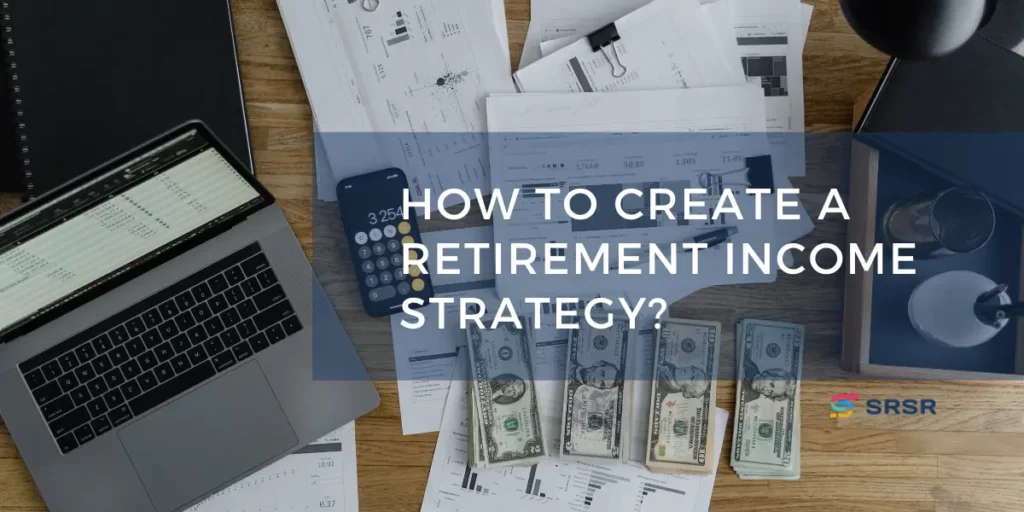Retiring after working for several decades can feel a bit like entering unknown territory. Instead of receiving an income from the work you do, you’re now relying on income streams generated from work you’ve already completed. Your retirement income strategy will help you plan how and when to access these income streams.
Being retired gives you more freedom to spend your money on vacations, hobbies, or other activities you didn’t have time for while you were working. But even if you’ve done an excellent job-saving money for retirement, you still need to plan carefully to make sure you don’t spend your money too quickly. By taking the time to develop a retirement income plan, a general retirement plan and regularly revisiting and adjusting it, you can increase your chance of achieving financial security during your retirement years.

What is a retirement income strategy?
During your working years, you are accumulating assets that will either generate income for you during retirement or that you will slowly sell to create an income stream you need to live on during retirement. Your retirement income strategy helps you plan and manage your income during retirement. It helps you decide how and where to invest your money, how much you need to save, and how and when to sell off your assets to maximize your retirement enjoyment.
Retirement income can come from many places, such as retirement accounts like an IRA or 401(k), Social Security, annuities, pension plans, and certificates of deposit. It could even come from resources like selling real estate you own or earning an income from renting your property. Planning your income strategy can help you allocate your funds into each savings vehicle and increase your chances of financial security in retirement.
You can use your retirement income strategy to help you with financial planning, both while you’re working towards retirement and after retirement as you budget and adjust your goals each year.
How to assess your current financial situation
You need to know where you are so you can plan where you’re going, and you can start planning by assessing your financial situation right now. Here are a few questions you can ask yourself:
- How many years do you have until you retire?
- How much do you currently have saved in investments, cash, or in other assets such as real estate?
- How much do you have in debt?
- What would you like your annual income to be when you retire? Make sure you think about things like whether you’ll have a mortgage payment, if you plan to do a lot of traveling or other big-ticket items you may continue paying for during retirement.
- How many years do you expect to live past your retirement? Although it’s impossible to predict how long you’ll live, you can estimate it based on the average life span of people your age. Once you know have an estimate of how long you’ll be retired, you can begin thinking about how much you need to save before retirement.
You can use a retirement savings calculator to estimate how much you should save each year between now and retirement. Remember that this is just an estimate, and that saving more is never a bad idea.

Why you should consider your retirement goals
Many people think they’ll save for retirement when they’re older and closer to retirement age, or when their salary reaches a certain level. However, the earlier you begin saving, the better. Compound interest increases your savings more effectively the longer you have your money invested.
Your retirement savings goals will be different based on your age. Saving for retirement in your early years allows more time for your money to grow. However, retirement planning in your 50s and 60s may require more aggressive or strategic investing and planning.
How to generate income during retirement is the most important part of retirement because you are no longer receiving a paycheck. You want to be careful not to take out too much money to not outlive your assets.
Setting your retirement goals now allows you to focus on setting aside money and investing it with an eye toward your ultimate goal of having an enjoyable retirement without needing to worry about your income. And having a plan for your money motivates you to stick with your savings and investments plan.
And if you’re already retired, having a plan for your money gives you the freedom to spend your money on enjoying your life, rather than worrying whether you’ll have enough to live for the rest of your life.
Developing a retirement income plan
Every person is unique and has different comfort levels and goals for their retirement income. Because of this, there are several different strategies for planning your retirement. Here are a few common retirement income strategies.
Bucket Strategy

The bucket strategy involves strategically spreading out your assets into different “buckets”. The buckets are periodically reorganized to plan and allocate funds across the buckets.
The first bucket is made of mostly cash, but could also include money in high-yield savings accounts or short-term CDs. This bucket will hold all the money you’ll need to access over the short term, perhaps in the next three to five years. This bucket should also include enough to cover emergencies or any major expenses you have planned for the next few years.
The second bucket is short-term, low-risk investments. This bucket will hold the money you plan to access in four to ten years, depending on your comfort level. Your investments in this bucket could include CDs and bonds that will continue to grow over the coming years. You can use money from this bucket to replenish your first bucket as you spend it on your expenses. You can also strategize your required minimum distributions and place them into the appropriate bucket as needed.
The third and final bucket is for funds you don’t plan to access for ten or more years. You can invest this money more aggressively in the stock market or other types of investments. Then, if the market sees a dip, your investments will have time to recover before you access the funds.
Certainty Strategy
The certainty strategy involves investing money to gain certain growth. For example, if you know you need $80,000 next year and can invest at a 4% guaranteed interest rate, you could invest $76,923 today. Then, in a year, your $80,000 will be available. Alternatively, you could invest in Treasury Inflation-Protected Securities to avoid inflation.
This strategy involves estimating how long you’ll live as well as strategically optimizing your investments. It doesn’t provide as much flexibility as some other retirement income strategies, and it requires a large infusion of cash upfront.
Static Strategy
The static strategy uses well-known investing principles to provide a steady income. With this strategy, half of your retirement should be invested in bonds while the other half is in stocks. Though the stocks may experience more volatility, they also give a greater chance for rapid growth.
Retirees will withdraw their retirement funds at a fixed rate, usually 4% of their nest egg. Each year this amount will be adjusted for inflation to continue to provide enough income to live on, even if prices go up. Half of the withdrawal will come from the bonds and the other half from the stocks. Then, the money should be reallocated so that half is in stocks and the other half is in bonds.
The low 4% withdrawal rate has been shown to still provide sufficient income for thirty years without depleting the initial investment, even when calculated using the worst historical stock market years.
Variable Strategy
This retirement income strategy is based on the idea that retirees’ spending habits often create a “spending smile” pattern. Early in retirement, people often spend extra money on travel or other leisure activities. Then, as their mobility decreases, their spending may decrease as well. Finally, in their later years, spending may increase again due to medical issues.
This spending smile pattern is normal for many retirees. Using this strategy allows you to plan for greater spending earlier in retirement, followed by a period of lower spending before spending ramps back up.
Insuring Strategy
The insuring strategy involves using retirement annuities to provide a guaranteed income. To use this method, you use the lump sum of your retirement investments to purchase an annuity. There are a few different types of annuities. One is an immediate annuity, which would begin paying out immediately while a deferred annuity delays the beginning of the payouts. Generally, the annuity would provide a guaranteed income until death.
One downside of this retirement income strategy is that if you put all of your savings into an annuity, your income will be limited to the amount of your annuity payment. Even if you have an emergency, you can’t access the principle you initially invested in.
Finding the retirement income strategy for you
Any of these strategies can work, but they must be executed correctly and take things like taxes required minimum distributions into account.
Your retirement income strategy will depend on several different factors. Some of these include how long you need to plan retirement, how you plan to spend money during your retirement, whether you’d like to leave some of your nest egg for your beneficiaries, and what types of assets you plan to use to receive income from.
Many people choose to hire a wealth management firm during retirement to help them plan and allocate their resources properly. After all, you worked hard during your working years. Your retirement should be comfortable and enjoyable, and working with a professional can make sure that it remains that way.

